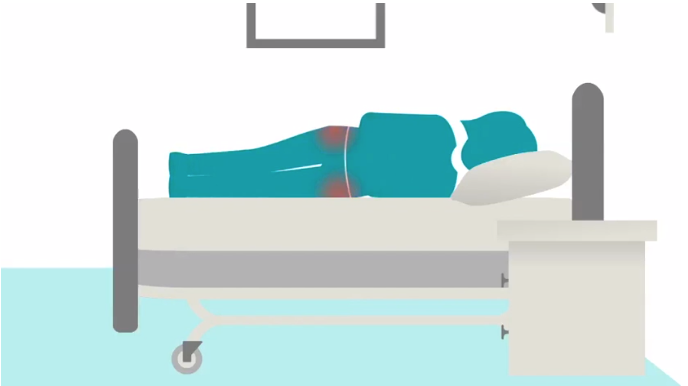Keeping patients and residents safe from pressure injuries

 Our bodies were made to move. When we sit or lie down in the same position for a long period of time, we’re at risk of developing pressure injuries – damage to skin that covers bony areas of the body (ankles, back, tail bone, elbows, heels) and tissue. These injuries can be painful and require time and support to heal. As part of our plan to keep patients and residents at our network as safe as possible, our teams are working on a number of different initiatives to prevent and reduce pressure injuries.
Our bodies were made to move. When we sit or lie down in the same position for a long period of time, we’re at risk of developing pressure injuries – damage to skin that covers bony areas of the body (ankles, back, tail bone, elbows, heels) and tissue. These injuries can be painful and require time and support to heal. As part of our plan to keep patients and residents at our network as safe as possible, our teams are working on a number of different initiatives to prevent and reduce pressure injuries.
Providence
Those most at risk for developing pressure injuries are people who are older, immobile, malnourished or have certain medical conditions such as dementia, diabetes, peripheral vascular disease, spinal cord injury or neuropathy. Residents living in the Cardinal Ambrozic Houses of Providence often have one or more of these conditions and, as a result, tend to be at higher risk. The team – led by Susan Chandler, a wound care expert, and Viani Tropiano, a practice consultant – has made prevention a priority with a strong focus on education, both for staff as well as residents and families, about what everyone can do to reduce the potential for these injuries. They’ve also focused on updating wound assessment and treatment protocols to ensure they’re following best practices, regularly conducting wound care rounds to check in on high-risk residents, and making sure those who need them have access to therapeutic, pressure-relieving mattresses, which they recently received more of thanks to a generous grant from Women in Philanthropy for Providence.
“We want our residents to feel as comfortable in the Houses as they would be in their own homes,” said Dr. Ashley Verduyn, “and part of that means keeping them injury-free. We’re always looking for new ways to prevent pressure injuries so that they stay as healthy as possible.”
St. Joseph’s
Earlier this year, the 4L Medicine team at St. Joseph’s hit 38 consecutive days without a new or worsened pressure injury – something that would’ve seemed impossible last year. The patients the unit cares for include many over the age of 60 and some recovering after a stay in the ICU. Earlier this year, the team started a “pressure injury champion” program, inviting five staff members to attend a two-day course to learn more about pressure injuries and develop prevention strategies.
“This was a team-based approach,” said Alice Feruelo, a team leader. “Once the champions had ideas, they went back to their colleagues to talk through them and confirm everyone was on board with the plan.”
The recommendations that have now been implemented include a daily safety huddle with a strong focus on pressure injuries, a new slogan (Save Our Skin, We All Win) worn on bright red T-shirts every Wednesday when the team measures every wound on the unit, and the goal to reach 30 consecutive days with no new or worse injuries – which the team has now reached almost three times.
“Everyone is really involved — in the times when we go back to zero days, everyone comes to the huddle saying, ‘What happened? Who was the patient?’” said Rosalyn Espiritu, an advanced practice clinical educator. “They’re so invested in seeing that number continue to count up.”
New employees to the unit are also immediately briefed on the importance of preventing these types of injuries and staff help one another to make sure patients are being checked in on regularly.
“Some of our team members actually come out from breaks for our safety huddles because they want to hear what’s going on,” said Evangeline Andaya, a patient care manager. “I think what’s made this so successful is the engagement from everyone – there’s team ownership to keep the momentum up, which I’m really proud to see.”
St. Michael’s
The Braden scale is a pressure injury risk assessment tool used by health-care organizations around the world to identify patients who are most at risk for developing pressure injuries before they actually develop one. Health-care providers use it to assess six areas: moisture, sensory perception, activity, mobility, nutrition, and friction and shear – each of which has a sliding scale that assigns a number depending on the patient’s condition. The lower a patient scores, the higher their risk for injury.
“At St. Michael’s, traditionally the Braden assessment is done within 24 hours of admission and then Monday, Wednesday and Friday for medical/surgical and ICU patients, and also if the patient’s condition changes,” said Cecilia Wan, an occupational therapist. “We’ve started a new process where nurses complete it for each admitted patient every shift so that we’re constantly aware of their condition and what areas we need to focus on.”
In addition to completing the assessment, nurses also create action plans for patients deemed to be at high risk to outline the steps they’re taking to reduce that risk. These action plans are available in patient charts so that any nurse or health-care professional caring for them can track what interventions have been put in place.
“We’ve been focusing on reducing pressure injuries for many years,” said Allison Rankine, a clinical co-ordinator for wound care, “and everything we do – including these changes of doing more frequent Braden assessments and action planning – helps keep our patients that much safer so they can get home as quickly as possible.”
Learn more about our network’s quality improvement initiatives.
